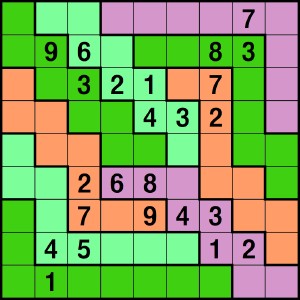


| we turn coffee into puzzles |
COLOR SUDOKU: Irregular Variations
|
Jigsaw
This variation is commonly called "Jigsaw Sudoku", because the usual Sudoku blocks have been replaced with regions that resemble pieces of a jigsaw puzzle. The numbers 1--9 must each appear in every row, column, and jigsaw region. In this particular example, notice how some patterns of clues mimic a pattern in the jigsaw design. This sort of "easter egg" is common in puzzles that are made by hand, and rarely seen in mass-computer-generated puzzles. This example of Jigsaw has difficulty level 2 out of 3. Tip: This variation doesn't just add conditions to the usual Sudoku rules, it actually changes the rules by changing the shapes of the block regions. This means that the usual Sudoku strategies won't apply here, at least without some modification. To "scan" under these new rules, try choosing one jigsaw region at a time and finding numbers to place in that jigsaw given the row and column restrictions. |
 |
 |
Snakes
This is a simple modification of the Jigsaw variation above, where the jigsaw regions are long and skinny like snakes. The numbers 1--9 must each appear exactly once in each row, column, and snake. This example of Snakes has difficulty level 1 out of 3. Tip: Look for long snake regions that hook around at the end. In this particular example, the lower left green snake is such a region. We can tell immediately that the two green cells in the hook contain the same numbers as the two purple cells at the end of the last row of the puzzle. |
|
Jigsaw Plus
In the Jigsaw variation above, we took away the usual Sudoku blocks and replaced them with jigsaw regions. In this variation we keep the usual Sudoku blocks and add jigsaw regions. The numbers 1--9 must each appear exactly once in each row, column, block, and jigsaw region. This is an original Brainfreeze variation. This example of Jigsaw Plus has difficulty level 2 out of 3. Tip: The are nine extra Sudoku regions in this example, which gives you a lot of information to work with even if not many initial clues are given. Use your usual Sudoku strategies together with the ones you developed for the Jigsaw variation. |
 |
| ← Previous variation | Next variation → |